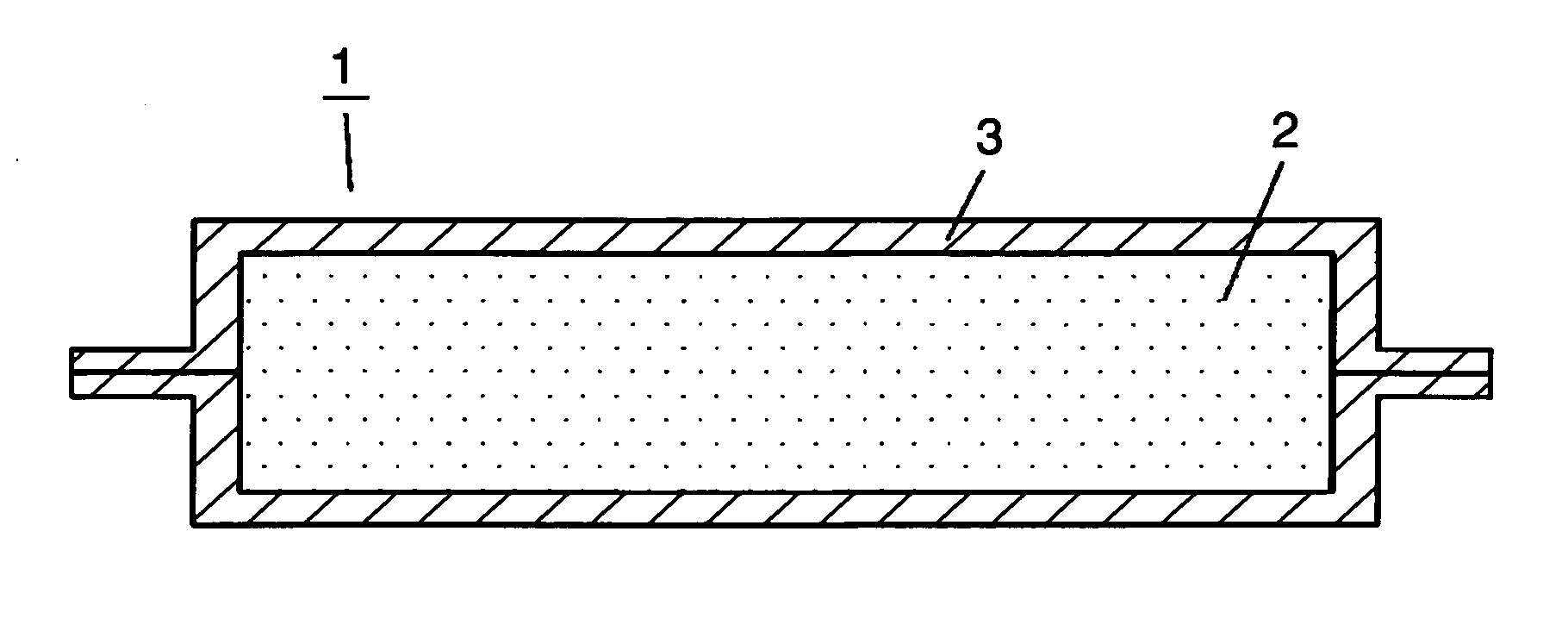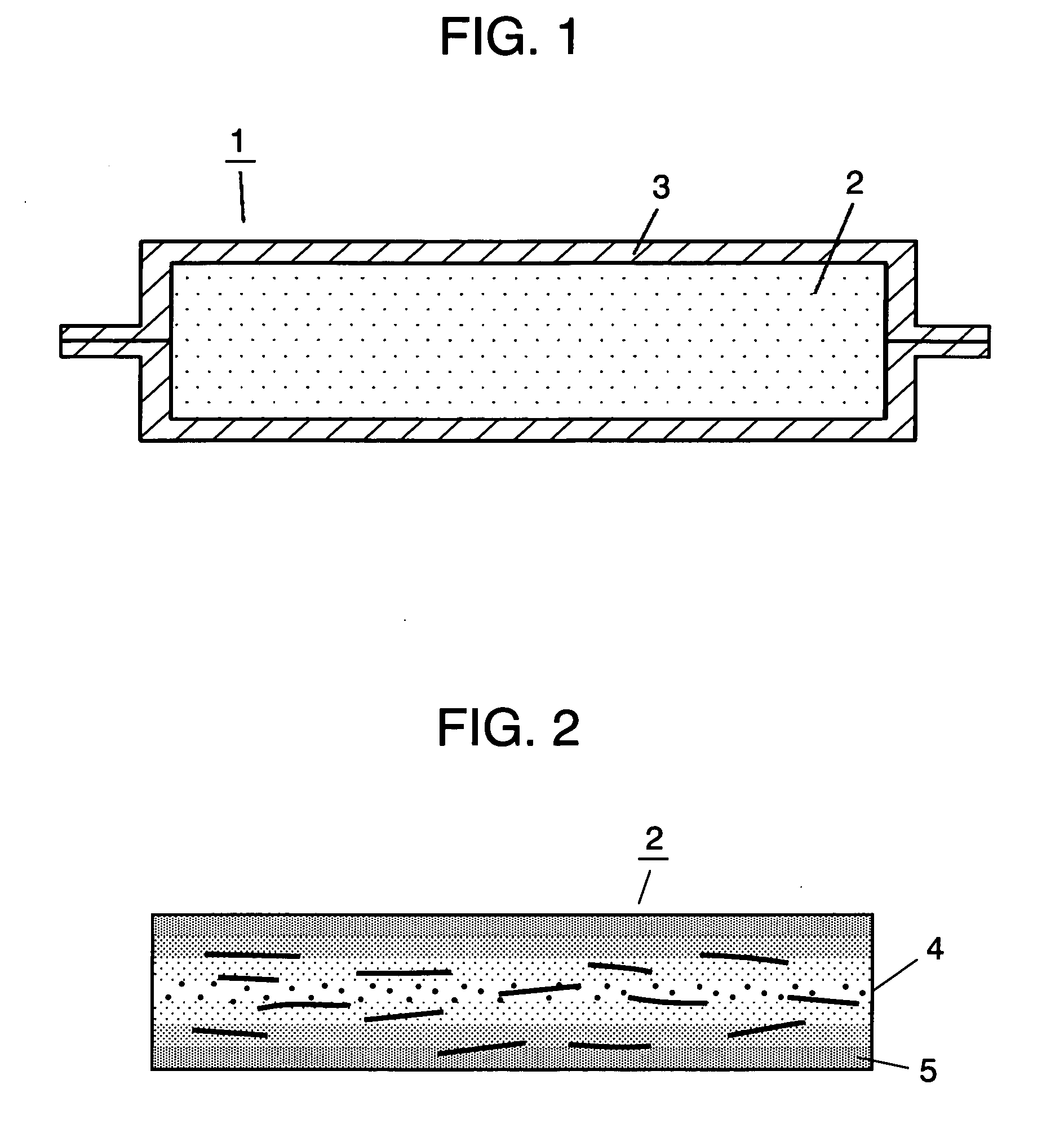Vacuum thermal insulating material, process for producing the same and refrigerator including the same
a technology of thermal insulation material and vacuum heat, which is applied in the direction of heat insulation for cooling apparatus, domestic cooling apparatus, lighting and heating apparatus, etc., can solve the problems of inability to apply measures and urgent problems for domestic electric appliances
- Summary
- Abstract
- Description
- Claims
- Application Information
AI Technical Summary
Problems solved by technology
Method used
Image
Examples
first exemplary embodiment
[0024]FIG. 1 is a cross sectional view showing a vacuum heat insulator according to a first exemplary embodiment of the present invention. Vacuum heat insulator 1 according to this embodiment includes core 2 and exterior covering 3 covering the same. Exterior covering 3 includes a gas-barrier film having a gas-barrier layer and a thermal fusing layer. An interior of exterior covering 3 is reduced in pressure. An opening of exterior covering 3 is thermally fused. Core 2 is formed by curing an inorganic fiber aggregate, which is laminated by a dry process to have an average fiber diameter of 5 μm, by means of a binding agent to make the same plate-shaped.
[0025] A method of manufacturing vacuum heat insulator 1 will be simply described below. After core 2 is dried at 140° C. for one hour, it is inserted into exterior covering 3. After an interior of exterior covering 3 is reduced to 13.3 Pa in pressure, its opening is bonded by thermal fusing.
[0026] The adiabatic performance (thermal...
second exemplary embodiment
[0049] Vacuum heat insulator 1 according to this embodiment is the same in fundamental constitution as that of the first exemplary embodiment shown in FIG. 1. This embodiment is different from the first exemplary embodiment in the structure of core 2. Core 2 in this embodiment is formed by coating an inorganic fiber aggregate which is laminated by the dry process to have an average fiber diameter of 7 μM, with a solid component of a phenol resin of 10 wt % as a binding agent and curing the same to make the same plate-shaped.
[0050] The adiabatic performance (thermal conductivity) of vacuum heat insulator 1 fabricated in this manner is measured at an average temperature 24° C. to be 0.0041 W / mK. Curing is adequately achieved since addition of the binding agent is 10 wt %. Since a decreasing rate of the thickness of core 2 due to reduction in pressure becomes 6%, atmospheric compression is small when vacuum heat insulator 1 is made, and the dimensional stability is sharply improved.
[...
third exemplary embodiment
[0055] Vacuum heat insulator 1 according to a third exemplary embodiment is the same in fundamental constitution as that of the first exemplary embodiment shown in FIG. 1. This embodiment is different from the first exemplary embodiment in the structure of core 2. Core 2 in this embodiment is formed by coating an inorganic fiber aggregate which is laminated by the dry process to have an average fiber diameter of 0.8 μm, with a phenol resin of 10 wt % as a solid component and curing the same to make the same plate-shaped.
[0056] The adiabatic performance (thermal conductivity) of vacuum heat insulator 1 fabricated in this manner is measured at an average temperature 24° C. to be 0.0024 W / mK. Curing is adequately achieved since addition of the binding agent is 10 wt %. Since a decreasing rate of the thickness of core 2 due to reduction in pressure is 5%, atmospheric compression is small when vacuum heat insulator 1 is made, and the dimensional stability is sharply improved.
[0057] Cor...
PUM
 Login to View More
Login to View More Abstract
Description
Claims
Application Information
 Login to View More
Login to View More - R&D
- Intellectual Property
- Life Sciences
- Materials
- Tech Scout
- Unparalleled Data Quality
- Higher Quality Content
- 60% Fewer Hallucinations
Browse by: Latest US Patents, China's latest patents, Technical Efficacy Thesaurus, Application Domain, Technology Topic, Popular Technical Reports.
© 2025 PatSnap. All rights reserved.Legal|Privacy policy|Modern Slavery Act Transparency Statement|Sitemap|About US| Contact US: help@patsnap.com



